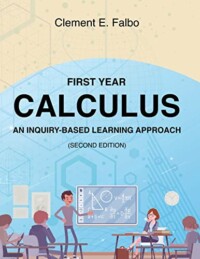Title: First Year Calculus: An Inquiry-Based Learning Approach (Second Edition)
Author: Clement E. Falbo
Publisher: Writers Branding
ISBN: 978-1959151494
Genre: Mathematics
Pages: 358
Reviewed by: Allison Walker
Pacific Book Review
The Moore Method, or Texas Method, was used by Dr. R.L. Moore at the University of Texas Austin to teach mathematics from 1930-1970. In that classroom, as a student, Clement E. Falbo learned to use and appreciate the teaching technique that would eventually be modified and called Inquiry-Based Learning (IBL). In fact, a large portion of Falbo’s textbook, First Year Calculus: An Inquiry-Based Learning Approach (Second Edition, is based on transcriptions from Falbo’s notes as a student in Moore’s class. In the simplest terms, IBL is a math class taught by students. Truly, a nightmare for introverts. Of course, the obvious advantage is to teach something is to truly understand it. If you do not understand what you are teaching, you will not be an effective teacher. Thus, in teaching the problem the others, you are reinforcing it for yourself. In his textbook, Falbo explains how to guide this teaching method in much greater detail. However, the basic premise is that students take turns teaching the entire class how to solve the problems.
Many years after completing Moore’s class, Falbo was able to implement IBL in his own mathematics classroom, while he was serving in the Peace Corp in Zimbabwe. While Falbo’s teaching experience didn’t end there – no one who wasn’t a teacher could have written this textbook – that is where he ends his explanation of the research that was used to complete First Year Calculus. And unfortunately, learning by example in a math class in the late 1950s don’t lend very obvious relevancy to a textbook published sixty years later. Falbo’s command of calculus is unquestionable but it’s strange to tease a biography and abruptly end it.
First Year Calculus is a beautiful textbook. It flows well and follows a logical learning sequence. Each chapter follows this pattern: a written description of the concept being learned and how to solve it, followed by a series of questions and answers to provide examples in support of the concept, then a series of homework problems to be solved and later taught by the students. The appendix provides solutions to the homework, sometimes providing more than one solution, as there are often many different ways to solve the same problem. In IBL, more than one way to access a solution is encouraged. Falbo points out that it’s advantageous for teachers to assign one student-teacher who has referenced the appendix and one who has not yet peeked because they may offer more than one way to teach the solution to the rest of the class. In addition to the content, the formatting of this textbook is flawless. Calculus is a graph-heavy, formula-heavy math, even at its introductory level. Falbo spent time on the design of this textbook to make sure every graph and every formula landed neatly on the page.
Falbo’s First Year Calculus could easily lend itself to a traditional, lecture-based classroom setting. It has all the necessary pieces. It has something other textbooks lack, though: IBL. And Falbo doesn’t make IBL difficult to learn or implement in the classroom. He encourages that this learning method is easy to understand and easy to use, empowers students to assume more active roles in their learning, and encourages cooperation among students in the classroom. All it takes is a teacher, like Falbo, willing to use it.


